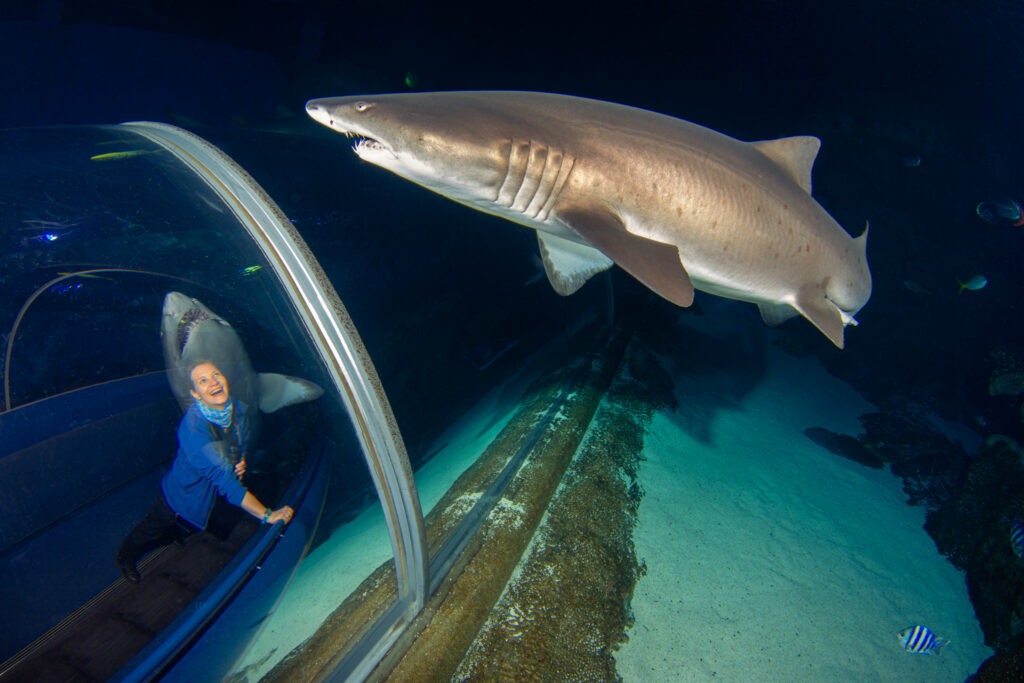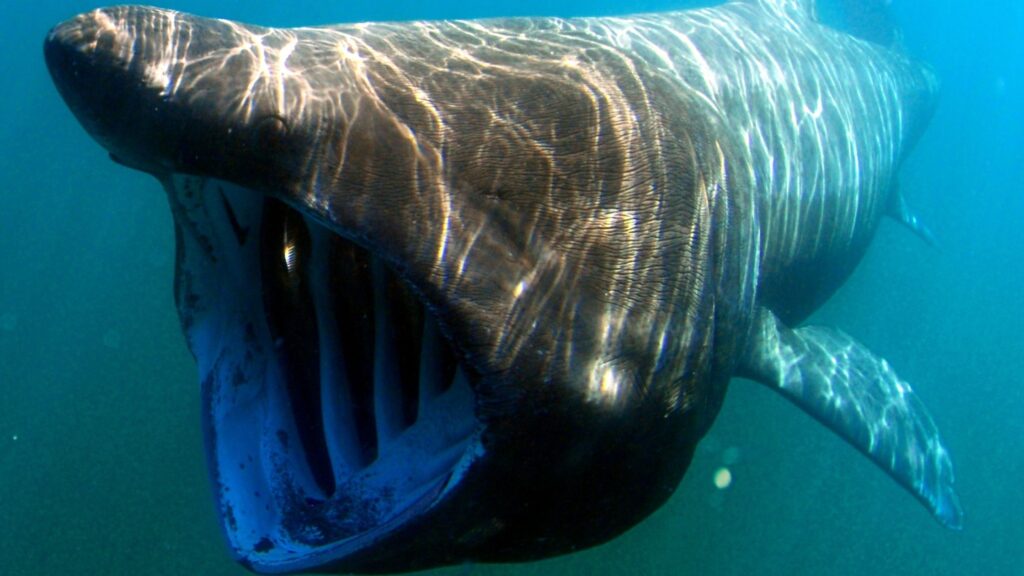Sharks. The name alone instils fear. These ancient beings have inhabited the depths since before the dinosaurs. Placing them among the most fascinating creatures beneath the waves. Why then do they attract such stigma? And should we really be scared of them?
At Blue Planet Aquarium, we think it’s high time people gave sharks a second chance. Ever since Spielberg’s Jaws hit the big screen in 1975, sharks have attracted more fear than they have a fascination. With myths and half-truths gaining attention ahead of facts and conservation.
With shark numbers in sharp decline, it’s time to get wise to these amazing creatures before it’s too late. To help, we’ve put together a guide on everything you need to know about sharks. So you can get to grips with just how wonderful and valuable they really are.
Use the links below to explore our guide or read on for the ultimate guide to sharks.
- Is a Shark a Fish or a Mammal?
- How Many Species of Sharks Are There?
- What Do Sharks Eat?
- Do Sharks Lay Eggs?
- How Long Do Sharks Live?
- What are the Biggest Species of Shark?
- Where Do Sharks Live?
- How Do Sharks Sleep?
- Are Sharks Endangered?
- Do Sharks Eat Humans?

Is a Shark a Fish or a Mammal?
First things first: sharks are fish. Given the size of some species of shark, it’s easy to see why some people mistake them for mammals. However, they are indeed fish – albeit, very big ones!
The simplest way to determine a shark’s fish pedigree is to note the gills. These are just in front of the pectoral fins on the side of their body. As with all fish, these gills take in water, forcing it through lots of tiny blood vessels. These vessels absorb oxygen from the water, allowing sharks to breathe underwater without rising to the surface. Clever, eh?
Sharks account for some of the largest species of fish in our oceans. The biggest being the mighty whale shark. These enormous fish can reach a length of 10 metres and weigh in at over 19 tonnes. This is the equivalent of 15 Ford Fiestas! Basking sharks and Megamouth sharks complete the top 3 biggest species. While the smallest known shark is the dwarf lantern shark, which averages just 6 inches in length.
How Many Species of Sharks Are There?
There are over 1,000 species of sharks that we know of, with new species discovered every year. As our understanding of the ocean widens and technology continues to improve. It’s guaranteed that hundreds of new shark species will be discovered in the coming years.
Sadly, however, shark numbers are in decline. This is why organisations like the WWF are campaigning for greater conservation efforts to protect their numbers. Every species of shark, from the great white to the bonnethead, plays a crucial role in our marine ecosystems. Each helps to balance a delicate natural order that would otherwise suffer.
It’s hoped that as our understanding of sharks deepens, more countries will introduce legislation to stop shark hunting. Hopefully, their numbers will return. As has been the case with several species of protected whales. The next few years will prove critical in safeguarding these incredible animals. With a view to not only discover more species but protect those we already know about.

What Do Sharks Eat?
Sharks are opportunistic feeders, eating everything from small fish and invertebrates to seals, penguins, sea birds, and whale carcasses. They detect their prey in several ways. Including sight, sound, vibration and, of course, smell. With a shark able to pick up the smell of blood from over a quarter of a mile away.
You’d be forgiven for thinking that larger shark species eat bigger prey, but this isn’t always the case. Sure, a great white could pick off something as formidable as a leopard seal with ease. Bigger species, like basking and whale sharks, are filter feeders, preferring to munch on microscopic plankton.
Despite what films like Jaws may have led you to believe, sharks don’t eat humans. Instead, preferring to stay out of our way. When attacks do happen, it’s usually the case that a shark has got confused or feels threatened.
Do Sharks Lay Eggs?
Some sharks lay eggs and others give birth to live young. This is what’s called ‘viviparity’ or ‘ovoviviparity’; there are more sharks which bear live young than those that lay eggs, and it differs from species to species.
Take the whale shark, for example, the classic example of ovoviviparity. Here, this species produces eggs but doesn’t lay them. Instead, the young hatch inside the female’s body, only to emerge when they’ve reached a particular size.
When we refer to viviparity, this is when a shark releases a capsule containing an egg and a yolk sac. These have tendrils designed to anchor them to the seabed. When the baby sharks hatch inside the capsule, they get nutrition from the yolk sac. Eventually being released from the capsule.
Some sharks, like the shortfin mako, give birth in an altogether different way known as oophagy. This is when unfertilised eggs are ‘eaten’ by embryos inside the shark before babies are released.
So yes, sharks do lay eggs, but it’s not quite as simple as that. Just another reason why they’re such fascinating animals.

How Long Do Sharks Live?
Most species of shark live between 20-30 years in the wild. This can vary widely depending on the size and species. Greenland sharks, which are found in the North Atlantic Ocean, are thought to be the oldest known species. These elders of the deep grow just 1cm a year. Scientists believe that the oldest known example is around 512 years old. So it’s been around since Henry VIII was on the throne.
What are the Biggest Species of Shark?
The mighty whale shark is the biggest species of shark in our oceans. At an average length of around 12 metres. Though, specimens of up to 19 metres have been reported (that’s larger than a football penalty area). Despite their size, these huge animals pose no threat to humans. They are only ever found in subtropical waters above 21°C. So there’s little chance you’ll spot one while eating your fish and chips at the seaside.
Here’s a look at the top 10 biggest shark species, ranked by average size order.
- Whale shark – 12-17 metres
- Basking shark – 12-15 metres
- Megamouth shark – 7-10 metres
- Tiger shark – 6-10 metres
- Greenland shark – 6-10 metres
- Great white shark – 6-10 metres
- Great hammerhead shark – 5-9 metres
- Thresher shark – 4-8 metres
- Bluntnose sixgill shark – 4-7 metres
- Pacific sleeper shark – 3-7 metres
Where Do Sharks Live?
Sharks live in all five oceans, the Pacific, Atlantic, Indian, Arctic and Southern. They’re also found in some freshwater lakes and rivers. The majority of shark species are migratory. This means they travel vast distances to remain in temperate waters with a good stock of prey.
Such is the diversity of shark species, they’ve adapted to live in both warm, shallow coastal water and deep, cold waters close to the Polar regions. That’s why shark sightings are common in countries like Australia, South Africa and the USA. As well as in much colder regions like Greenland and the southern coast of South America.

How Do Sharks Sleep?
Sharks don’t sleep. Instead, they have active and rest periods, wherein they either preserve or expel energy.
That’s not to say that all sharks are forever swimming. Some, such as the nurse shark, rest in a stationary position. The majority of sharks, however, do swim even when they’re in a state of rest. Preferring to do this in deeper water.
Are Sharks Endangered?
Yes. Many species of sharks are classified as endangered by the WWF. Such as the great white, hammerhead and whale shark. Sharks face all kinds of threats. Including rising sea temperatures, overfishing, habitat loss, illegal fishing and increasing demand for shark fin. Their fins are a key ingredient for an expensive soup in some Asian countries.
Organisations like the WWF are doing all they can to safeguard shark numbers. Pressuring governments to pass legislation making shark fishing illegal and tagging endangered species in an effort to monitor their numbers. Also, by spreading awareness and understanding of sharks and their value to marine ecosystems. If illegal fishing stops, it’s hoped their numbers will recover.
Do Sharks Eat Humans?
The biggest and most damaging myth about sharks is that they eat humans, which isn’t true. When shark attacks happen, it’s a matter of wrong place, wrong time – not of predator and prey. The next time you take a swim and start thinking about the Jaws theme tune, put it out of your mind. Remember, the likelihood of being attacked by a shark is 1 in 3.75 million.
So, there you have it, our no-nonsense guide to one of the ocean’s biggest and best creatures of the deep. For more information on these incredible animals, and for an opportunity to swim alongside them, visit the Blue Planet Aquarium homepage or give us a call on 0151 357 8804.
